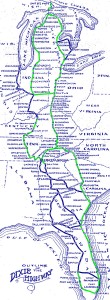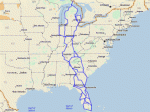 The first time I entered the Twenty Mile House it was smaller and younger and so was I. I was in my twenties so perhaps could even be considered young in absolute terms. Not so the building. The part on the right was built in 1822. Some or all of a building that stood here in 1804 might even be included in there somewhere. The road was smaller then too. It was small enough that cars parked between it and the building where those shrubs are now. The main entrance was through a street facing door that has long been locked and sealed. Some details of the first time I stepped through that door remain clear. The bar was against the far wall. I’m not entirely sure what was to my left; Probably some tables and chairs. I don’t recall the huge fireplace that I now know fills the east wall so am guessing that it was covered at the time. To my right was a jukebox and a hardwood dance floor that sat on top of the “normal” floor. Les Paul & Mary Ford’s version of How High the Moon was playing. That recording is almost as old as me.
The first time I entered the Twenty Mile House it was smaller and younger and so was I. I was in my twenties so perhaps could even be considered young in absolute terms. Not so the building. The part on the right was built in 1822. Some or all of a building that stood here in 1804 might even be included in there somewhere. The road was smaller then too. It was small enough that cars parked between it and the building where those shrubs are now. The main entrance was through a street facing door that has long been locked and sealed. Some details of the first time I stepped through that door remain clear. The bar was against the far wall. I’m not entirely sure what was to my left; Probably some tables and chairs. I don’t recall the huge fireplace that I now know fills the east wall so am guessing that it was covered at the time. To my right was a jukebox and a hardwood dance floor that sat on top of the “normal” floor. Les Paul & Mary Ford’s version of How High the Moon was playing. That recording is almost as old as me.
 The building started out as an inn and stagecoach stop some twenty miles from the center of Cincinnati. It seems to have been successful in that role. And it must have been somewhat successful as some sort of road side stop as the stage route became Montgomery Road and Ohio Route 3 and the 3C Highway and US Route 22. I don’t really know whether the outside of the building changed much during its first century and a half. I do know it hasn’t changed in any material way in the many years since. The inside, however, has changed considerably and additions have been made until the structure I remember from the early 1970s makes up maybe a third of the total. A recent sales flyer includes a diagram of the building in which I believe the area labeled “Bar & Lounge” is the original structure. Perhaps there is a version of the “Peter Principle” that applies to restaurants. Something like: “A successful eating establishment will expand to a size just beyond what the customer base can support.” This was an extremely successful restaurant and night spot through the seventies and eighties. That’s when the additions were made and every occupant since then has had that huge capacity — and overhead — to deal with.
The building started out as an inn and stagecoach stop some twenty miles from the center of Cincinnati. It seems to have been successful in that role. And it must have been somewhat successful as some sort of road side stop as the stage route became Montgomery Road and Ohio Route 3 and the 3C Highway and US Route 22. I don’t really know whether the outside of the building changed much during its first century and a half. I do know it hasn’t changed in any material way in the many years since. The inside, however, has changed considerably and additions have been made until the structure I remember from the early 1970s makes up maybe a third of the total. A recent sales flyer includes a diagram of the building in which I believe the area labeled “Bar & Lounge” is the original structure. Perhaps there is a version of the “Peter Principle” that applies to restaurants. Something like: “A successful eating establishment will expand to a size just beyond what the customer base can support.” This was an extremely successful restaurant and night spot through the seventies and eighties. That’s when the additions were made and every occupant since then has had that huge capacity — and overhead — to deal with.
 In my mind, the sprawling additions have been a factor in the failure of various restaurants to make a go of it but it’s hard to say just how big a factor. The most recent tenant may have actually found all that space attractive. That was a business called Red Rock Tavern and it advertised itself more as a music venue than as a restaurant. It didn’t last long but it left its mark. They painted the building red. Some previous tenant had mounted a scrolling electric sign board on the corner of the building. It’s still there in the picture in the real estate flyer. The Red Rock folks painted around it so that removing it left a scar like stripe. Rumor has it that the kitchen was pretty much stripped at the same time.
In my mind, the sprawling additions have been a factor in the failure of various restaurants to make a go of it but it’s hard to say just how big a factor. The most recent tenant may have actually found all that space attractive. That was a business called Red Rock Tavern and it advertised itself more as a music venue than as a restaurant. It didn’t last long but it left its mark. They painted the building red. Some previous tenant had mounted a scrolling electric sign board on the corner of the building. It’s still there in the picture in the real estate flyer. The Red Rock folks painted around it so that removing it left a scar like stripe. Rumor has it that the kitchen was pretty much stripped at the same time.
The red paint and the grey “scar” provide an ugly building to go along with an ugly situation. Speedway, the gas station chain, found the location, if not the building, attractive. They want to demolish the building and put in a gas station and convenience store. An offer was made but there was a hitch. The property is at the corner of Columbia Road and US 22. There is an entrance on both roads but Speedway stated that it needed an entrance from Columbia much closer to the corner than the existing one. That would be a violation of Warren County access management regulations. The existing entrance is, in fact, closer than current regulations permit but was grandfathered in. This is truly a safety concern in the minds of many and the county engineer has refused to grant an exception.
Beyond this it gets pretty muddled. Apparently the county commissioners and possibly even the Deerfield Township commissioners have the power to overrule the engineer. They haven’t done so and have become the target of a lawsuit by Jeff Black, the building’s owner. They have also become the target of many local residents who feel they should buy the building to preserve it or somehow otherwise firmly block the development. I have no idea how all this fits with the fact that, late last year, Speedway submitted plans that omitted the entrance change.
I’ve come to the game embarrassingly and frighteningly late. I heard of the situation months ago but did nothing other than sign an electronic petition. I marked my calendar for a zoning committee meeting a couple of weeks ago but blew it off for something else. On Tuesday I did attend a township commissioner meeting but it was almost immediately apparent that the meeting was rather meaningless in regards to the fate of the Twenty Mile House. It was a chance for residents to relate how much they liked the old building and tell how its destruction would be a great loss but the commissioners had already come out firmly against buying the property which seemed to be the only method available to them to actually prevent the proposed demolition. For the record, I am not a resident of the county or township involved. I live at the edge of Hamilton County. Warren County and Deerfield Township are two streets and 300 yards from my front door.
 I can’t even guess at what might happen next. I only know that I’ll be watching. I suppose that part of the reason for making this post is the hope that it might get a few more people watching, too. Several articles here offer glimpses of what has already transpired and the post and replies here offer glimpses of what once was. The petition I mentioned is here though, like almost all online petitions, it has no legal standing. I am aware of two Facebook connections. One is a fan page which may signal its attitude in its title, Save 20 Mile House – Boycott Speedway. The fact that there has so far been only something to be against and nothing to be for can be seen in the name. The other is a group whose name, Friends of 20 mile house, is less abrasive. Fans of the page and members of the group overlap heavily. Hopefully someone will come up with a better plan than lying down in front of bulldozers. On the other hand, I attended that commission meeting with a sixty year old Deerfield Township resident whose mother, knowing his feelings on the matter, cautioned him to “not get arrested”. It could happen.
I can’t even guess at what might happen next. I only know that I’ll be watching. I suppose that part of the reason for making this post is the hope that it might get a few more people watching, too. Several articles here offer glimpses of what has already transpired and the post and replies here offer glimpses of what once was. The petition I mentioned is here though, like almost all online petitions, it has no legal standing. I am aware of two Facebook connections. One is a fan page which may signal its attitude in its title, Save 20 Mile House – Boycott Speedway. The fact that there has so far been only something to be against and nothing to be for can be seen in the name. The other is a group whose name, Friends of 20 mile house, is less abrasive. Fans of the page and members of the group overlap heavily. Hopefully someone will come up with a better plan than lying down in front of bulldozers. On the other hand, I attended that commission meeting with a sixty year old Deerfield Township resident whose mother, knowing his feelings on the matter, cautioned him to “not get arrested”. It could happen.
UPDATE: 27-Mar-2012 – As reported here, Speedway has withdrawn its offer to purchase the 20 Mile House. That is merely a short reprieve as the historic building is still for sale and financial pressures on the current owner have not gone away. Taking advantage of the breather, the previously mentioned Friends of 20 mile house Facebook group has formed a non-profit corporation using the name Friends of The Twenty Mile House. This will allow fund raising and provide focus for locating and assisting preservation minded purchasers.
UPDATE: 1-May-2013 – Time ran out for the Twenty Mile House. The property was sold in March, a demolition permit issued, remaining fixtures were sold in an online auction, and, on April 16, the building was leveled. A blog entry on the demolition was posted here the next day. The order for destruction came from Henkle Schueler & Associates who plan to build a Big Mike’s Gas n Go at the location. In justifying the unpopular action, the company has used silly phrases like “its historical significance can be measured in the physical location, not in its structure” and referred to the gas station as “a place for those traveling through the area to refuel and gather provisions” and called this a continuation of past use. I think they may have invented the phrase “functionally demolished” to describe a building with furniture and fixtures removed. The idea that Henkle Schueler thinks people who cared about the place believe this is insulting. The idea that they may actually believe it themselves is frightening.
UPDATE: 20-Jan-2018 — Two years after the demolition, a third post (Twenty Mile Stand Two Years On) was written that includes a look at how the new structures relate to what was destroyed.

 The
The  I was pretty much prepared to not like this. I only became aware of
I was pretty much prepared to not like this. I only became aware of 

 Late in the spring of 2004, the lens on my A20 zoomed its last. As I recall, it was stuck somewhere in the middle of its range. It still took pictures but the lack of zoom was irritating and the permanently protruding lens made it awkward to pocket. Besides, there had been three years of progress since my last camera purchase and I was ready to take advantage of it.
Late in the spring of 2004, the lens on my A20 zoomed its last. As I recall, it was stuck somewhere in the middle of its range. It still took pictures but the lack of zoom was irritating and the permanently protruding lens made it awkward to pocket. Besides, there had been three years of progress since my last camera purchase and I was ready to take advantage of it.